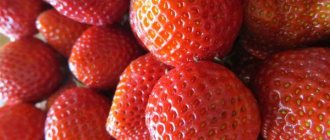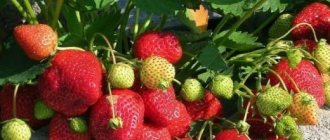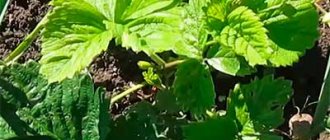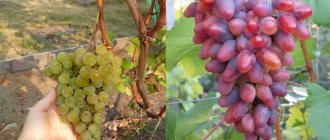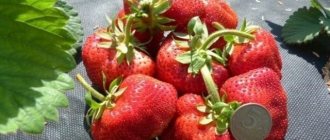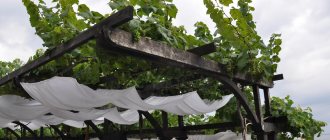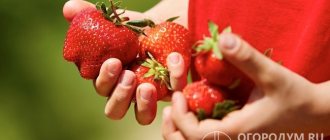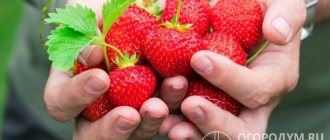Description of the strawberry variety Temptation
This strawberry produces flower stalks not only on the bush itself, but also on young tendrils
Strawberry Temptation F1 is an early-ripening, remontant variety. The bushes grow of medium size. The leaves are also medium in size and dark green in color. Quite a lot of whiskers are formed for further reproduction. This strawberry produces flower stalks not only on the bush itself, but also on young tendrils that have not even taken root yet. This is the main feature of this species as an ampelous one.
Interesting!
Strawberries Temptation can produce crops throughout the year if you create the right conditions for this. This is one of the qualities for which the hybrid is valued above many other species.
The berries grow weighing 20-30 g. They are large, round in shape, with a spout. Color red. The pulp is dense, with a high juice content. The fruits have a delicate taste and a rich, nutmeg aroma.
The fruits have a delicate taste and rich, nutmeg aroma.
Growing remontant strawberries
Watering and fertilizing strawberries
Growing remontant strawberries is not much more difficult than simple ones. It needs the same care as varieties of simple strawberries, but if in the case of the latter, the main care occurs in spring and early summer, when the plant bears fruit, then in the case of remontant varieties, care lasts until the first frost, when the bushes finally depart to bed.
The peculiarity of care in this case is constant watering and fertilizing. The latter is carried out only with the safest fertilizers that cannot harm berries, flowers and bushes. Fertilizing is necessary for remontant varieties to maintain the strength of the plant, because constant fruiting requires a lot of nutrients and cultural strength, so do not forget about this
It is also important to regularly weed the bushes and remove weeds, because they interfere with normal air circulation and spread diseases and pests
If you choose the right remontant strawberry varieties for your plot and take proper care of them in a timely manner, you can provide your family with healthy berries for the whole year!
Characteristics of strawberry Temptation
Also check out these articles
- When to plant cabbage seedlings in 2021
- Omshanik for bees
- Akhal-Teke horse
- Feeding cabbage seedlings
This hybrid has many special qualities that distinguish it from many other types of strawberries.
- Ampel strawberry Temptation has a short fruit ripening period.
- For more than 3 years in one place, this strawberry does not produce many berries, so it is replanted every three years.
- There is a tendency to produce a profuse mustache.
- The crop ripens regardless of the length of daylight hours or the time of year.
- The variety needs proper watering and adequate fertilizing, otherwise the yield will decrease.
- The yield per bush reaches 1.5 kg.
- The bushes have extended fruiting.
- Frost resistance is average, up to -17 degrees.
- There is a strong immunity to some of the most common diseases.
Frost resistance is average, up to -17 degrees
Main characteristics
Let's try to figure out which of the available data can be considered reliable, and what should be regarded as just another marketing ploy. Let's start with the most significant characteristics:
| Parameter | Characteristic |
| Culture | Strawberry (Fragaria ananassa) |
| Ripening time | Early |
| Type of fruiting | Remontant |
| Photoperiodic type | Neutral daylight hours |
| Productivity | High: from 500-900 g to 1.5 kg per bush |
| Mass of berries | On average – 15-20 g, maximum – up to 35 g |
| Fruit shape | Round-cone-shaped |
| Berry color | Dark red with a glossy sheen |
| Pulp | Red, juicy, dense |
| Purpose | Universal |
| Educational ability | High |
| Productive life cycle | No more than 3 years |
| Sustainability | The hybrid is medium-winter hardy; weakly resistant to heat and drought |
| Registration in the State Register of the Russian Federation | Turned off |
Despite the abundance of commercial offers from foreign and domestic manufacturers, there is essentially no objective information about the origin and “pedigree” of the hybrid, the properties and characteristics of the plant.
Strawberry seeds of the hybrid variety “Temptation” from various foreign producers
This hybrid is not officially registered in the State Register of the Russian Federation, as well as in Belarus and Ukraine; accordingly, it has not undergone variety testing and does not have uniform standards. Therefore, you have to rely on contradictory and often very controversial reviews about the “Temptation” strawberry from gardeners who have already become acquainted with it in practice.
Ripening dates and fruiting characteristics
Since the hybrid belongs to the day-neutral category, it lays fruit buds regardless of the length of daylight hours and begins to bear fruit in the first year after planting.
Experts recommend removing the first flower stalks on young plants, giving the bushes time to get stronger in order to increase yields in subsequent waves of fruiting due to the number and size of berries.
“Temptation” is classified as an early-ripening variety: the first fruits begin to ripen from late May to mid-June. The processes of flowering and ripening of berries continue throughout the entire growing season of the plant until late autumn. The great advantage of “Temptation” is considered to be the ability to bear fruit not only on the main bushes, but also on daughter rosettes (and even without rooting them), which significantly increases productivity.
Due to numerous long peduncles lying down under the weight of berries, and tendrils with fruiting rosettes, when placing plants on vertical or hanging structures, a “cascade” effect occurs.
Day-neutral varieties bear fruit remontantly, that is, many times during the season. Peaks in yield are observed every 4-6 weeks and in favorable conditions in open ground, plants are capable of 3-4 waves of active fruiting.
Amateur gardeners believe that it is necessary to renew plantings of remontant varieties and hybrids at least every 2-3 years. In commercial production, they are grown primarily as an annual crop.
Remontant plants quickly become depleted, as they spend a lot of effort on producing several waves of harvest and growing shoots (candrils), often not having time to accumulate in the root system a sufficient supply of nutrients necessary for a successful wintering. Therefore, most remontant crops are not highly frost-resistant and require reliable shelter, especially in the middle zone and more northern regions. In the presence of snow cover, frosts down to −17 ℃ are considered to be the limit for the Temptation hybrid; it also does not tolerate heat and drought well, which significantly affects yield indicators.
The yield potential of the hybrid is quite high, but is fully revealed only under the most favorable weather and climatic conditions and intensive agricultural technology
On adult bushes, a large number of long peduncles (over 20) are formed, on which multi-flowered inflorescences are located. The flowers are bisexual and tend to self-pollinate, so the hybrid is well adapted to growing in protected ground without the access of pollinating insects. Yields are assessed as very high: up to 1.5 kg of berries per bush per season. According to gardeners, these figures are very exaggerated and are possible only under the most favorable conditions and intensive agricultural technology; in practice, on average, they receive 500-900 g.
Commercial and consumer qualities of berries
The hybrid is positioned as large-fruited, with a maximum weight of berries up to 30-35 g. On average, the fruits gain 15-20 g (and according to gardeners, even less - 10-12 g). The berries have an elongated, rounded, cone-shaped shape and, when ripe, acquire a rich red color and glossy shine. The pulp is quite dense, juicy, fleshy, without voids. According to gardeners, the taste qualities of the “Temptation” strawberries are quite high: the berries are sweet with a barely noticeable sourness and a spicy nutmeg aroma. Numerous yellow seeds, weakly pressed into the pulp, small and tender - practically not felt.
The berries have a leveled presentation, uniform in size and shape, and are easily transported
The dense texture of the berries allows them to be transported and versatility of use. They are considered suitable for fresh consumption, all methods of processing, and freezing.
Reproduction
Aspects of the reproduction of the Temptation hybrid deserve special attention. Modern hybrid forms of garden strawberries show good results in seed propagation.
A specialist from the Garden World online store talks about the technology of growing strawberry seedlings from seeds in the following video:
The method of seed propagation is quite labor-intensive and time-consuming; even experienced gardeners are not always successful, but it allows one to obtain healthy seedlings. For germination, you can use only purchased high-quality seeds, preferably from trusted manufacturers. It is important to pay attention to the release date, since the seed material remains viable for no more than 3 years. Seeds collected independently from ripened berries are unsuitable, since the combination of genetic characteristics of the “parents” in hybrids is unstable and appears only in the first generation (F1).
Many well-known domestic agribusinesses, Aelita, Poisk and others, produce and sell strawberry seeds “Temptation F1”.
Further propagation of plants is carried out by traditional vegetative methods: daughter rosettes or division of bushes. “Temptation” produces a large number of tendrils, so there are no problems with obtaining the necessary supply of planting material. For all its simplicity and accessibility, vegetative propagation has one significant drawback: seedlings receive from their mother plants all the viruses they have accumulated over time.
Agrotechnical requirements
Any large-fruited, especially remontant berry crops require constant attention and care. When growing “Temptation” strawberries, it is important to comply with all standard agrotechnical requirements:
- regular watering - frequent and abundant (especially in the absence of precipitation) throughout the entire growing season. Experts recommend using drip irrigation systems to prevent the soil from drying out;
- fertilizing - in fertile areas it is necessary to apply humus, compost or complex mineral fertilizers, preferably with the addition of manganese and zinc, 2-3 times per season (in depleted areas - 5-6 times) per season. When growing in canopies, foliar feeding should be carried out;
- weeding and loosening of the soil - carried out as necessary, preventing the strawberry beds from becoming overgrown with weeds and the formation of a crust on the surface of the earth. Many gardeners and farmers prefer to mulch the soil with straw, pine needles or artificial materials, which makes caring for the plantings much easier;
- preventive treatments against diseases and pests.
A layer of organic mulch or black agrofabric prevents the evaporation of moisture from the soil and the growth of weeds, reduces the risk of contamination and spoilage of berries
Plants of this hybrid bear fruit almost constantly, so they need a sufficient area of nutrition and do not respond well to thickening of plantations. It is recommended to plant them at a distance of 45-50 cm from each other, and as they grow, regularly remove excess tendrils and drying leaves.
Peculiarities of propagation of the Temptation variety
To preserve the characteristic qualities of the variety, propagation is usually carried out by mustaches. To select mustaches, healthy bushes are selected. The tendrils are rooted as they appear, and when the rosettes grow, you can separate them from the mother plant and plant them.
You can grow Temptation strawberries from seeds, but you need to buy specialized, branded ones, because seeds collected from grown strawberries do not have maternal qualities.
To grow bushes from seeds, they are sown in containers about 8 cm high (they must have holes for water drainage). Drainage is done at the bottom of the cups, then neutral acid soil is filled in. It is best to take a mixture of universal soil and sand in a 2:1 ratio. Now you can sow the seeds and cover them with film. The crops are ventilated every day, and they need to be watered as needed.
You can grow Temptation strawberries from seeds, but you need to buy branded seeds
In about 1-2 weeks the first shoots will appear. When 2-3 leaves appear, you can plant the seedlings in separate containers. 2 weeks before transplanting to a permanent place, the seedlings begin to harden.
Strawberry propagation
Remontant strawberry variety Temptation reproduces:
- seeds;
- sockets;
- dividing the bush.
As you can see, the methods of reproduction are traditional. For those who have been involved in culture for more than one year, they do not present any difficulties. But from the characteristics it follows that obtaining new seedlings from seeds is not always possible. Let's take a closer look at the process.
Where to get seeds
The choice of seeds is of great importance:
- The seed remains viable for only three years. Therefore, when purchasing seeds of the remontant variety Temptation, you need to pay attention to this point.
- You need to purchase seeds in specialized stores.
- It is better to use the services of agricultural firms that have gained popularity in the Russian market. In these seed companies, the seeds undergo thorough testing and comply with GOST standards.
Companies such as Aelita, Becker, Altai Gardens, Siberian Garden and others are very popular. You can order Temptation garden strawberries by mail or online, since today all companies have an official website.
Soil for seedlings
They have been growing Temptation strawberries from seeds since February in order to obtain high-quality seedlings by spring. The remontant garden strawberry variety requires nutritious soil with good air permeability. When making your own soil mixture, take into account the following ratio: to three parts of sand you need to add five parts of compost or humus.
Three days before sowing the seeds, the soil is disinfected. You can heat it in the oven or pour boiling water over it. Potassium permanganate is added to it. The fact is that the soil may contain spores of black leg disease, which is dangerous for strawberries of all varieties. They die under the influence of heat treatment.
Features of sowing and care
As already noted, the seeds of the remontant strawberry variety Temptation take a long time to germinate. They are sown on soil well-drained with warm water. There is no need to cover the seed, since microscopic seedlings cannot break through even a small layer of soil. The containers are covered with glass.
In a room with a temperature of at least 25 degrees, garden strawberry shoots appear within a month. The shelter is not removed, just opened a little to maintain heat and high air humidity.
In the future, remontant strawberries will require good lighting. Gardeners in their reviews note that seedlings of the Temptation variety require light for 12 hours a day. If there is not enough light, the seedlings will stretch out. Therefore, it is necessary to install lamps to highlight strawberries.
Planting seedlings of garden strawberries (if they are grown in common containers) begins after 2-3 true leaves appear.
In the future, caring for remontant strawberries of the Temptation variety comes down to watering and fertilizing.
Attention! When watering, it should be taken into account that the water should not stagnate. Otherwise, problems with the root system will begin.
The variety's seedlings respond well to watering with wood ash extract, which contains a large amount of microelements necessary for the plant to develop successfully.
Before planting in open ground, the bushes of the remontant strawberry Temptation are hardened off so that adaptation is successful.
Picking seedlings of remontant garden strawberries of the Temptation variety from peat tablets:
Other methods of reproduction
Since the formation of tendrils on the hybrid is continuous, and the unrooted rosettes already have buds, remontant strawberries can be propagated all summer and autumn. And not only with rosettes, but also by dividing the bush.
Attention! No matter how strawberries of this variety are propagated, the heart should not be buried when planting.
Features of planting the variety
We recommend reading our other articles
- Tomato variety Eagle's beak
- Angelica honey and its properties
- Apricot Shalah
- Chicken diseases and their treatment
You can grow hanging varieties of strawberries using the usual method, in the ground. But it’s most convenient to grow them in hanging flowerpots, on a balcony, in greenhouses, or simply in boxes stacked side by side (hanging beds). Planting of seedlings is carried out in warm weather (if they are planted in open ground). The place for planting is chosen to be sunny and not swampy. The land must be fertile and fertilized.
It is most convenient to grow in hanging flower pots, on the balcony, in greenhouses or simply in boxes
Holes for bushes are made with a distance of 45-50 cm. Plants are placed in each hole so that the roots are located downwards and not upwards. At the same time, the core of the bush cannot be buried! Sprinkle the bushes on all sides, compacting the soil with your hands. After planting, the beds are watered.
Interesting!
To prevent pests from growing in strawberries, you can plant onions, garlic or herbs between plantings.
Growing in soil
Before planting in open ground, seedlings must have at least six leaves. The best place is a sunny garden bed with fertile soil. Since the Temptation variety is grown in one place for 3 years, the soil must be well filled with organic matter so that there is enough nutrition for the entire time. Of course, fertilizing will be required, but in smaller quantities.
Seedlings are planted in May or June, depending on the climatic conditions of the region. The main thing is that the average daily temperatures are positive.
Despite the fact that, according to the description of the variety and reviews from gardeners, strawberries are a compact bush, holes are dug at a distance of 45-50 cm. In this case, onions, garlic, herbs or fragrant flowers can be planted between the plants to repel pests.
Mandatory events
- Remove weeds and loosen the soil. Working with garden strawberries can be made easier if you mulch the surface under the plantings with straw or dry grass. This is not only additional nutrition, but also an opportunity to retain moisture in the soil, avoid the growth of weeds, and the berries will be clean.
- Planting in summer requires abundant watering during budding and flowering. During mass ripening of berries, strawberries are watered less frequently and in smaller volumes so that the fruits are not watery.
- Fertilizers are introduced along with watering. Plants respond well to foliar feeding with ammonia at the beginning of the growing season. It is useful to water strawberries with mullein, infusion of green grass and nettle. You should also sprinkle the plants and soil with wood ash. Fertilizing strawberry plantings with boric acid:
- Since the Temptation variety is famous for its huge number of whiskers, this makes care somewhat difficult. But these parts of the plant must be removed, just like drying leaves.
- Treatment against diseases and pests should be regular. There is no need to wait until the plants begin to wilt: prevention is the best cure.
- Before wintering, strawberries are pruned, but not at the root, otherwise the growth buds can be removed. The plantings are treated with Bordeaux mixture and covered with spruce branches. If the plant variety is grown in central Russia or in the northern regions, serious cover of the beds will be required.
Remontant ampelous strawberry Temptation F1 is an interesting hybrid that produces a harvest with any growing method. It is fashionable to pick berries in an apartment or heated greenhouse all year round.
Caring for ampelous strawberries Temptation
In care, the ampelous strawberry Temptation F1 is considered unpretentious, but without proper care it grows quickly and reduces the yield significantly.
- Watering is carried out regularly so that the soil does not dry out. During flowering they are carried out more often than usual. And when the berries begin to ripen, watering is reduced, otherwise the strawberries will be watery.
Watering is carried out regularly so that the soil does not dry out.
- As weeds appear, they need to be pulled out and burned outside the area or used to create compost.
- The ground under the bushes can be mulched so that the water does not evaporate quickly and weeds grow in smaller numbers.
Important!
If the Temptation strawberry is not provided with regular watering, its yield may be greatly reduced.
- At the beginning of the growing season, plants are fed with nitrogen fertilizers. You can also water the bushes with an infusion of herbs (nettle, for example). Strawberries also respond well to the addition of wood ash in dry form or in infusions.
- In order for the yield to be high and the berries to grow tasty, it is necessary to leave only one, the first rosette, which the bush produces, and all subsequent ones that grow from this first rosette are torn off.
The ground under the bushes can be mulched
- In the fall, before the plant goes into dormancy (if it grows in open ground), it is necessary to remove all dry leaves and mulch the beds and the plants themselves with hay or straw.
- To prevent the bushes from getting sick and not being affected by pests, it is necessary to treat them with insecticides or fungicides about 2 times a year. It is best to use broad-spectrum products.
Diseases and pests
Despite the fact that strawberries of the Temptation variety are highly resistant to various diseases, if not carefully cared for, there is a danger that the plant will develop such ailments as:
- Gray rot. This fungal disease can be caused by an abundance of dampness and poor ventilation, which is why a fluffy white coating appears on the berries of this variety. The destruction of all infected fruits and subsequent treatment of the diseased plant with copper chloride will help get rid of this scourge.
- Powdery mildew. The first sign of infection will be the appearance of spots on the leaves of the bushes, then they turn brown and curl. It is impossible to save a plant infected with this disease. It is destroyed, and healthy bushes are treated for preventive purposes with a weak solution of potassium permanganate or colloidal sulfur.
- Brown spot. This disease leads to intensive falling of strawberry leaves. To eliminate it in the spring or at the end of the harvest, the bushes are treated with a solution of copper chloride.
- Strawberry mite. The appearance of this parasite is accompanied by yellowed and curled leaves, and the bushes themselves stop growing. As a treatment, immediately after harvesting, the plant is sprayed with karbofos.
- Aphid. An effective remedy against this pest is a solution of ash mixed with shavings of laundry soap.
Harvesting and processing
The harvest is harvested as the berries ripen. They cannot be stored for a long time, but for 3-7 days they remain without deterioration in appearance or taste. At the same time, strawberries can be transported over long distances.
Interesting!
Berries that are picked in the fall are usually tastier and much more aromatic than those that ripen in the summer.
Temptation strawberries are usually used for fresh consumption.
Temptation strawberries are usually used for fresh consumption. It is also suitable for making jam, jam, jelly, baked goods and desserts. This berry does not lose its taste even after freezing and drying.
Reviews from gardeners about the strawberry variety Temptation
As gardeners note, the Temptation strawberry has both positive and negative sides. So every gardener must weigh the pros and cons before purchasing this hybrid.
- Angela Shurko : “I bought this variety along with the Ostara variety in a seed store. There were only 10 seeds in the bag. I planted it as indicated on the package, I did everything only according to the instructions. The seeds sprouted very poorly; out of 10, only 6 sprouted, but only 4 bushes survived. Now they grow on level beds. The bushes are strong and beautiful, but I wouldn’t say there are a lot of berries; there are also more productive varieties.”
- Sasha Nikitin : “I grew strawberries Temptation F1 with seeds. The variety is good, and yet out of 20 seeds purchased, only 15 sprouted. The yield is not bad, the bushes are resistant to many diseases, they react normally to temperature changes and winter well. So this year I will buy 20 more pieces, but in the form of bushes, because there is too much hassle with the seeds.”
- Ksenia Komarova : “I love the Temptation variety for the taste of berries and pleasant aroma. When the berries ripen, the aromas are amazing. There is not enough harvest to sell, but there is more than enough for food and winter supplies. After cooking, the berries do not lose their taste. I also like to freeze these strawberries - the berries withstand this procedure better than many other varieties. Plus, once defrosted, they retain their shape and taste good."
